Oracle Bundle
Who Really Owns Oracle Corporation?
Unraveling the ownership of Oracle Corporation is key to understanding its strategic moves and market dominance. From its humble beginnings in 1977 to its current status as a tech giant, Oracle's ownership structure has evolved significantly. This evolution has shaped its trajectory and influence in the enterprise software and cloud services arena. Discover the key players and their impact on the company's future.
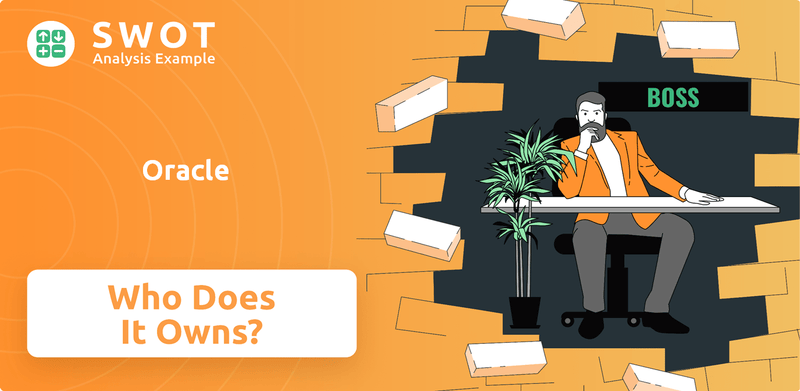
Understanding Oracle SWOT Analysis is crucial for investors and analysts alike. Tracing the Oracle ownership journey, from its Oracle founder Larry Ellison to the present day, reveals a fascinating story of corporate governance and market adaptation. Knowing who owns Oracle helps to decipher the company's strategic priorities, its commitment to innovation, and its accountability to its stakeholders. Exploring Oracle's current CEO and owner and the dynamics of its public shareholding provides valuable insights into its enduring success and future path. This exploration will also touch upon Oracle's acquisition history, Oracle Corporation parent company, and the influence of its board of directors.
Who Founded Oracle?
The story of Oracle Corporation, initially known as Software Development Laboratories (SDL), began in 1977. It was brought to life by three key individuals: Larry Ellison, Bob Miner, and Ed Oates. Their vision was to create a groundbreaking database management system, setting the stage for a company that would become a giant in the tech industry.
At the company's inception, the ownership structure reflected the contributions of its founders. Larry Ellison, the driving force, held the largest initial stake. While specific percentages from the absolute inception are not publicly detailed, it is widely acknowledged that Ellison held a controlling interest from the outset, reflecting his leadership in developing the core database technology. Bob Miner and Ed Oates also held significant equity positions, though smaller than Ellison's.
Early funding for SDL primarily came from the founders themselves, supplemented by small contracts. There were no notable angel investors or friends and family who acquired substantial stakes during this initial phase. The early agreements likely involved standard vesting schedules to ensure founder commitment. The founding team's collective vision to create a robust relational database management system was inherently tied to their shared ownership, with Ellison's substantial stake reflecting his outsized influence on the company's technological direction and business strategy from its very beginning.
Larry Ellison, Bob Miner, and Ed Oates founded Oracle in 1977.
Ellison was the primary visionary and held the largest initial stake.
Miner and Oates also held significant equity positions.
Funding primarily came from the founders and early contracts.
No significant angel investors or early external funding rounds.
Early agreements likely included vesting schedules.
No major ownership disputes or buyouts in the early stages.
The initial equity distribution remained relatively stable.
Ellison's stake reflected his influence on the company.
The founders aimed to create a robust relational database.
Their shared ownership was crucial to their vision.
Ellison's leadership shaped the company's direction.
Ellison focused on technological vision and strategy.
Miner was a key programmer.
Oates managed early customer relations.
Ellison had a controlling interest from the start.
Miner and Oates had significant, but smaller, stakes.
Equity reflected contributions and roles.
Understanding the early ownership of Oracle provides insight into its foundational structure and the influence of its founders. The initial ownership structure, with Larry Ellison holding a controlling interest, set the stage for the company's future. The early focus on developing a relational database management system, coupled with the founders' shared vision, was critical to Oracle's early success. This early framework has shaped the company's evolution into one of the leading technology companies. If you want to learn more about how Oracle competes in the market, you can read about the Competitors Landscape of Oracle.
- Larry Ellison's significant stake from the outset.
- The founders' self-funding and early contracts.
- The stability of the initial equity distribution.
- The team's shared vision for a relational database.
Oracle SWOT Analysis
- Complete SWOT Breakdown
- Fully Customizable
- Editable in Excel & Word
- Professional Formatting
- Investor-Ready Format
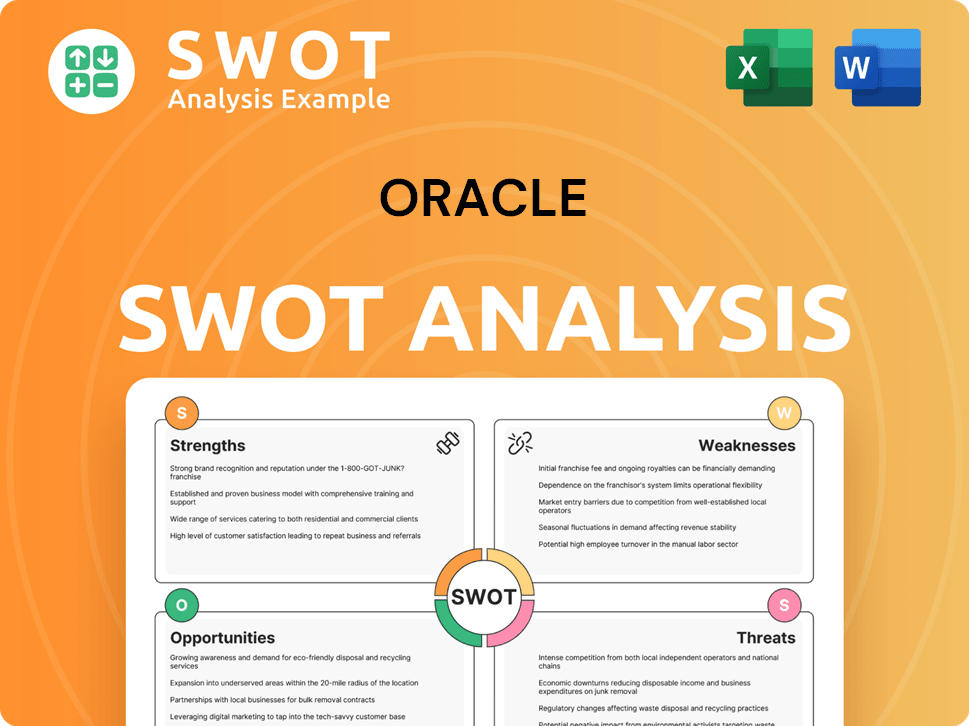
How Has Oracle’s Ownership Changed Over Time?
The evolution of Oracle Corporation's ownership has been marked by key events that shaped its structure. Following its initial public offering (IPO) on March 12, 1986, the company transitioned from a founder-controlled entity to a widely held public company. This IPO was a pivotal moment, establishing Oracle as a major player in the software industry and setting the stage for its future growth and changes in ownership.
The company's growth, including strategic acquisitions, further influenced its ownership dynamics. These acquisitions, coupled with the natural progression of market forces, have led to a complex ownership structure. The company's journey reflects the interplay of founder influence, institutional investment, and the broader market's impact on a major technology firm. Understanding Oracle's ownership structure provides insights into its strategic direction and governance.
| Event | Impact on Ownership | Year |
|---|---|---|
| Initial Public Offering (IPO) | Transitioned from founder-controlled to public company. | 1986 |
| Growth through Acquisitions | Influenced the distribution of shares among institutional and individual investors. | Ongoing |
| Market Performance | Affected the valuation and investor interest in Oracle shares. | Ongoing |
As of early 2025, Larry Ellison, the Oracle founder, remains the largest individual shareholder, holding approximately 42.9% of the common stock. This substantial stake gives him significant influence over the company's strategic decisions. Major institutional investors, such as Vanguard Group Inc. with around 8.6% of shares as of late 2024, and BlackRock Inc., holding about 7.3%, also play a crucial role in Oracle's ownership structure. This blend of founder leadership and institutional investment shapes the company's governance and strategic direction. To learn more about the company's strategic moves, you can read about the Growth Strategy of Oracle.
Oracle's ownership structure is a mix of founder control and institutional influence.
- Larry Ellison is the major individual shareholder, owning approximately 42.9% of the company's common stock.
- Institutional investors like Vanguard and BlackRock hold significant stakes.
- The shift towards institutional ownership has impacted the company's strategy and governance.
- Understanding the ownership structure provides insights into Oracle's strategic direction.
Oracle PESTLE Analysis
- Covers All 6 PESTLE Categories
- No Research Needed – Save Hours of Work
- Built by Experts, Trusted by Consultants
- Instant Download, Ready to Use
- 100% Editable, Fully Customizable
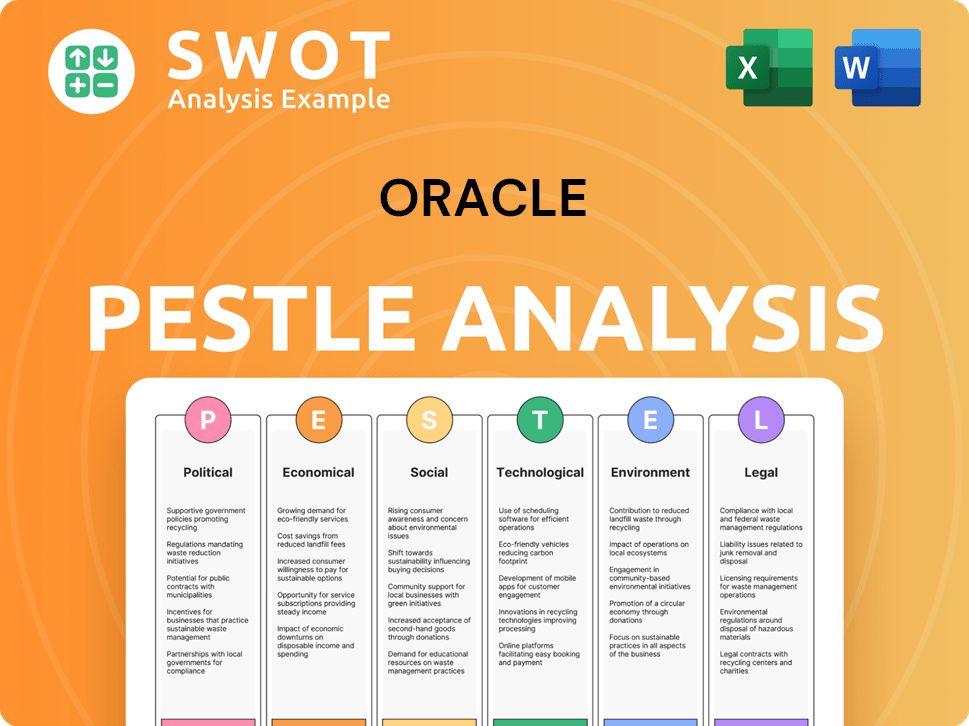
Who Sits on Oracle’s Board?
The Board of Directors at Oracle Corporation significantly influences the company's direction, balancing the interests of stakeholders, including its founder, institutional investors, and public shareholders. As of early 2025, the board includes individuals representing major shareholders, long-standing company executives, and independent directors. Larry Ellison, as Chairman and Chief Technology Officer, holds a prominent position, using his substantial ownership to maintain considerable influence over strategic decisions. Safra Catz, the Oracle CEO, also plays a key role, bringing extensive operational and financial expertise.
The composition of the board and its decision-making processes are designed to support Oracle's long-term strategy, often reflecting the vision set by its founder. This structure has generally maintained stability, with no recent proxy battles or activist investor campaigns significantly challenging the board or management. This stability is partly due to Ellison's substantial ownership, which tends to deter aggressive interventions. Understanding the board's structure helps in analyzing the dynamics of Oracle's target market and strategic direction.
| Board Member | Title | Key Role |
|---|---|---|
| Larry Ellison | Chairman and CTO | Significant influence over strategic decisions |
| Safra Catz | CEO | Operational and financial expertise |
| Independent Directors | Various | Oversee and provide independent perspectives |
The voting structure at Oracle operates primarily on a one-share-one-vote basis for its common stock. However, Larry Ellison's significant ownership of approximately 42.9% of the common stock grants him substantial control and voting power. There are no publicly known dual-class shares or special 'golden shares' that grant disproportionate voting rights beyond the common stock. Ellison's large stake is the primary mechanism for his continued influence, shaping the company's trajectory and strategic decisions.
Oracle's ownership structure is heavily influenced by its founder, Larry Ellison, who holds a significant portion of the company's shares. This gives him considerable control over company decisions. The board of directors, including Ellison and Oracle CEO Safra Catz, plays a key role in the company's governance.
- Larry Ellison's substantial ownership grants him significant voting power.
- The board's decisions often reflect the vision set by the founder.
- The company maintains a stable governance structure.
- There have been no recent major challenges to the board's authority.
Oracle Business Model Canvas
- Complete 9-Block Business Model Canvas
- Effortlessly Communicate Your Business Strategy
- Investor-Ready BMC Format
- 100% Editable and Customizable
- Clear and Structured Layout
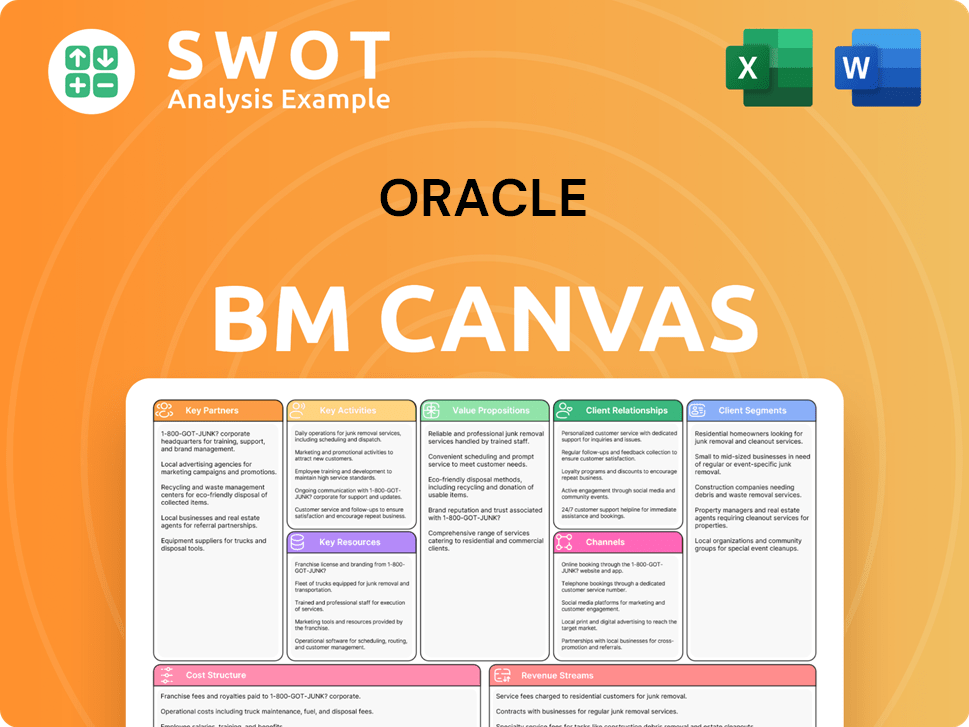
What Recent Changes Have Shaped Oracle’s Ownership Landscape?
Over the past few years (2022-2025), the ownership of Oracle Corporation has seen steady trends. A key aspect is the continued significant stake held by Larry Ellison, the company's founder, maintaining his long-term influence. This stability is a notable feature, especially considering broader industry shifts.
Simultaneously, share buybacks have played a role in the ownership dynamics. For example, in September 2023, Oracle authorized a $10 billion share repurchase program. These buybacks can increase the percentage ownership of existing shareholders, including Ellison and institutional investors. Furthermore, mergers and acquisitions, like the $28.3 billion acquisition of Cerner Corporation in June 2022, have expanded the company's scope without necessarily causing major shifts in core ownership percentages, unless new equity was issued.
| Ownership Aspect | Details | Recent Data (2024-2025) |
|---|---|---|
| Founder's Stake | Larry Ellison's Ownership | Consistently high, maintaining significant influence |
| Institutional Ownership | Holdings by major asset managers | Increasing concentration, with significant holdings by Vanguard and BlackRock |
| Share Buybacks | Company's capital allocation strategy | $10 billion share repurchase program authorized in September 2023 |
Industry trends reveal a growing concentration of ownership among institutional investors within the tech sector. For Oracle, this is evident in the substantial holdings of large asset managers like Vanguard and BlackRock. The current ownership structure appears stable, with a strong founder presence alongside a robust institutional investor base. If you're interested in how the company approaches its market, check out the Marketing Strategy of Oracle.
Larry Ellison maintains a substantial ownership stake, reflecting his continued influence over the company's direction. Institutional investors like Vanguard and BlackRock hold significant shares.
Share repurchase programs, such as the $10 billion authorization in September 2023, impact the ownership structure by increasing the percentage held by existing shareholders. These programs are a consistent part of Oracle's financial strategy.
Oracle Porter's Five Forces Analysis
- Covers All 5 Competitive Forces in Detail
- Structured for Consultants, Students, and Founders
- 100% Editable in Microsoft Word & Excel
- Instant Digital Download – Use Immediately
- Compatible with Mac & PC – Fully Unlocked
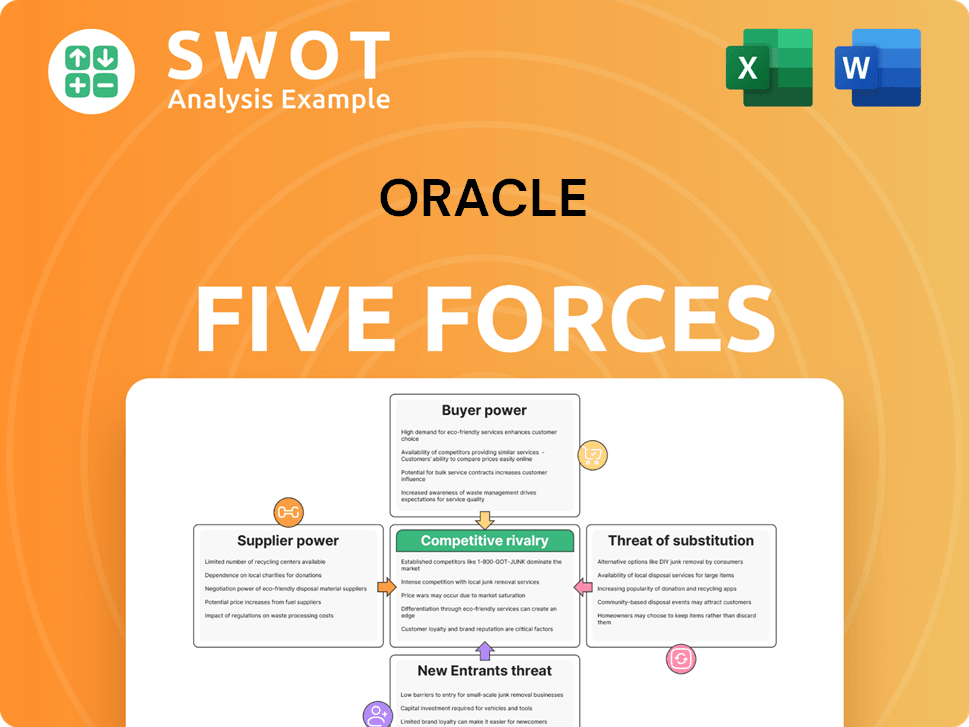
Related Blogs
- What are Mission Vision & Core Values of Oracle Company?
- What is Competitive Landscape of Oracle Company?
- What is Growth Strategy and Future Prospects of Oracle Company?
- How Does Oracle Company Work?
- What is Sales and Marketing Strategy of Oracle Company?
- What is Brief History of Oracle Company?
- What is Customer Demographics and Target Market of Oracle Company?
Disclaimer
All information, articles, and product details provided on this website are for general informational and educational purposes only. We do not claim any ownership over, nor do we intend to infringe upon, any trademarks, copyrights, logos, brand names, or other intellectual property mentioned or depicted on this site. Such intellectual property remains the property of its respective owners, and any references here are made solely for identification or informational purposes, without implying any affiliation, endorsement, or partnership.
We make no representations or warranties, express or implied, regarding the accuracy, completeness, or suitability of any content or products presented. Nothing on this website should be construed as legal, tax, investment, financial, medical, or other professional advice. In addition, no part of this site—including articles or product references—constitutes a solicitation, recommendation, endorsement, advertisement, or offer to buy or sell any securities, franchises, or other financial instruments, particularly in jurisdictions where such activity would be unlawful.
All content is of a general nature and may not address the specific circumstances of any individual or entity. It is not a substitute for professional advice or services. Any actions you take based on the information provided here are strictly at your own risk. You accept full responsibility for any decisions or outcomes arising from your use of this website and agree to release us from any liability in connection with your use of, or reliance upon, the content or products found herein.